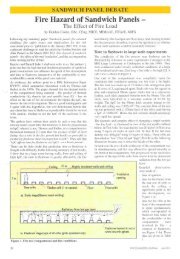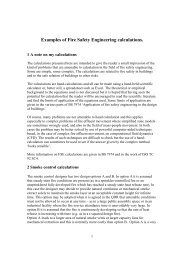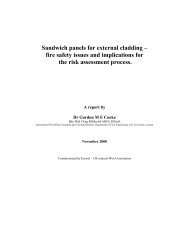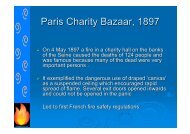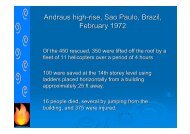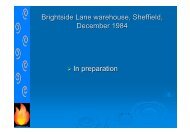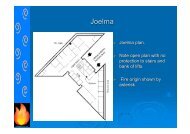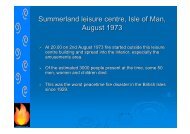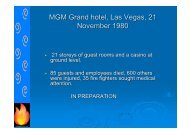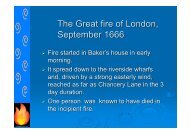Examples of Fire Safety Engineering calculations. - Cooke On Fire
Examples of Fire Safety Engineering calculations. - Cooke On Fire
Examples of Fire Safety Engineering calculations. - Cooke On Fire
Create successful ePaper yourself
Turn your PDF publications into a flip-book with our unique Google optimized e-Paper software.
Determine the rate at which the compartment will fill with smoke, and find the time forthe smoke to fill down to within 5m and 2m <strong>of</strong> floor level. Determine if occupants aresafe if they leave the building within 3 minutes <strong>of</strong> ignitionFigure. Cross section through portal framed buildingData given:average height <strong>of</strong> enclosure = 12.5m i.e. (12+13)/2length <strong>of</strong> building = 60mwidth <strong>of</strong> building = 40mambient air temperature, T0= 15 o Cdensity <strong>of</strong> air, ρ = 1.2kg/m 3specific heat <strong>of</strong> air C p = 1.92clear air layer needed = 6mfire growth parameter for fast t 2 fire a = 0.0444 kW/s 2height <strong>of</strong> virtual source above base <strong>of</strong> fire, z = 0From the literature (e.g. CIBSE Technical Memorandum TM19: 1995):o2⎪⎧t ⎪⎫Q = 1000⎨⎬( CIBSE Eqn 4.1) (1)⎪⎩ t g ⎪⎭where tg= characteristic growth time. For a fast fire tg= 150 and Equation (1) becomesQ = 0.0444t2M1/ 35/ 3= 0.071Qp( z − zo)(CIBSE Eqn 5.6) (2)Q= T(CIBSE Eqn 5.17) (3)pTm+MCpo2
vMTρ Tm= (CIBSE Eqn 5.19) (4)ooA spreadsheet is prepared which calculates smoke layer temperature and thickness as afunction <strong>of</strong> time.First we assume the worst condition, that the plume height z remains constant as timeprogresses (in reality the plume height reduces as the thickness <strong>of</strong> smoke layer increasesand thus the height over which air entrainment takes place reduces with time).Substituting data gives:time for smoke layer to reach down to 5m from floor level = 325sectime for smoke layer to reach down to 2m from floor level = 488secAssume now that the air entrainment reduces as the smoke layer increases in thicknessi.e. z reduces. We now have:time for smoke layer to reach down to 5m from floor level = 534sec time for smoke layerto reach down to 2m from floor level = 700secSo we see the large increase in smoke fill time, i.e. from 488 to 700 seconds for smoke toreach to within 2m <strong>of</strong> floor level. Thus using constant z is conservative – if occupantscould evacuate within this period they would be safe.We are asked if the occupants are safe to complete their evacuation by 3 minutes fromignition. From the calculation the smoke layer is approximately 2m deep (well abovehead height) and at a temperature <strong>of</strong> 34 o C for constant z and at 38 o C for reducing z, atthis time. The conditions are clearly tenable.3 Thermal deflections/stresses.3.1 The thermal bowing deflection at mid-height <strong>of</strong> a steel stud fire wallA firewall comprises a fire protecting layer <strong>of</strong> plasterboard either side <strong>of</strong> an assembly <strong>of</strong>steel studs. The vertical studs are <strong>of</strong> a light steel channel section 200mm deep betweenflanges and the studs are 6m high and simply supported at their ends. In an indicative fireresistance test on a 1m high specimen <strong>of</strong> the whole construction exposed to the ISO 834fire on one face it was found that the thermocouple temperatures <strong>of</strong> the ‘hot’ and ‘cold’flanges <strong>of</strong> the steel channel were 700 and 300 o C respectively. The two conditionsconsidered are shown in the figure below.Assuming a) the plasterboard does not affect the bowing behaviour, and b) the steelproperties are unaffected, what is the mid-height deflection ( ∆mid −height) <strong>of</strong> the 6m highwall in the horizontal direction assuming the same fire exposure?3
We see that we can assume the ends <strong>of</strong> the studs are free to rotate and that thetemperature difference across the stud channel section is the same as in the testFrom the literature (<strong>Cooke</strong> G M E, Stability <strong>of</strong> lightweight structural sandwich panelsexposed to fire, Structures in <strong>Fire</strong> (SiF 02) Conference Proc., University <strong>of</strong> Canterbury,Christchurch, New Zealand, March 2002, or <strong>Cooke</strong> G M E, When are sandwich panelssafe in fire ?- Part 2 Avoiding collapse, <strong>Fire</strong> Engineers Journal, UK, Sept 1998, pp 25 –33):Figure. The bowing <strong>of</strong> a 6m high steel stud wall2α H ( T1− T2 )∆mid − height=8 dWhereα = coefficient <strong>of</strong> linear expansion (14x10 -6 / o C for steel at elevated temperature)H = height <strong>of</strong> member (m)T1= temperature <strong>of</strong> ‘hot’ face ( o C)T2= temperature <strong>of</strong> ‘cold’ face ( o C)d = distance between faces (m)Substituting values in the equation gives:∆− 6 214 × 10 × 6 × (700 − 300)mid −height== 0.126m8 × 0.203.2 The thermal bowing deflection at the top <strong>of</strong> a steel stud firewall4
Using the same data as for the problem above, calculate the horizontal deflection at thetop <strong>of</strong> the wall ( ∆top) assuming it is a cantilever (i.e. it is direction-fixed (encastre) at thebase and free at the top to move both laterally and vertically)From the literature (as above example)2α H ( T T ) 1−2∆top=2 dComparing the denominator in this equation with the denominator in the equation in theabove example we see that the defection at the top is four times the deflection <strong>of</strong> thesimply supported member at mid-height, so:∆ top= 4 x 0.126 = 0.504m3.3 The thermal bowing deflection at the top <strong>of</strong> a tall steel stud firewall in asimulated fire resistance testIn a fire resistance test the measured horizontal deflection <strong>of</strong> a 3m high partition at midheightwas 200mm. What would be the corresponding deflection for a partition <strong>of</strong> thesame construction 6m high, assuming the same fire exposure conditions and onlygeometrical thermal bowing effects?Figure. Bowing deflection for double height wall.From the governing equation (as above example):5
∆mid −heightTherefore:α H=2∆mid − height= 200 ⎨2⎬ = 800( T1− T2 ), it is clear that deflection varies as the square <strong>of</strong> the height.2 d2⎧ 6⎩ 3⎫⎭mm3.4 The lateral bowing <strong>of</strong> a heated slender steel memberA very slender vertical steel rod 2m long is position-fixed at both ends, i.e. the rod is pinendedand the ends cannot move axially. It is then heated uniformly along the wholelength through a temperature <strong>of</strong> 400 o C. Determine the lateral bowing deflection at midlengthassuming a) the rod bows into a circular arc and b) the rod does not shorten due tocompression caused by axial restraint at the ends.20degCL=2mD420degCFigure. Effect <strong>of</strong> suppressing axial expansion <strong>of</strong> slender elementFrom the literature (<strong>Cooke</strong> G M E, Stability <strong>of</strong> lightweight structural sandwich panelsexposed to fire, <strong>Fire</strong> and Materials, 2004: 28: pp299-308 (for full details go to MyPublications, Sandwich panels)D = L( 0.375αT)1/ 2−61/ 2D = 2 (0.375×14×10 × 400) = 0.0916m3.5 The hypothetical expansion-restraint force for a squat steel sectionA solid steel section is 150mm square and 0.5m long. It is longitudinally restrained at itsends so that it is unable to expand longitudinally. It is heated from room temperature (say6
20 o C) to 700 o C, see figure below. What expansion force is developed, assuming elasticbehaviour and that buckling does not occur?stressElastic Modulus E = = strainP /∆ /AL(1)Where P = axial force (N)A = Cross-section area (mm 2 )∆ = unrestrained expansion (mm)L = length <strong>of</strong> member (mm)The unrestrained expansion is given by:Figure. Restrained axial expansion <strong>of</strong> steel section∆ = α L( T ) 1− T2 (2)Where α = coefficient <strong>of</strong> linear thermal expansion (14x10 -6 /oC for steel)T1= temperature when hot ( o C)T = temperature when cold ( o C)2Substituting (2) in (1) and rearranging gives:P = α AE( T ) 1− T2 (3)Assume E 700 = 0.3 <strong>of</strong> the room temperature value and assume room temperature value is200kN/mm 27
From Equation (3)P = 14 x 10 -6 x 150 2 x 0.3 x 200,000 x 680 = 12,852kN. Note that this is a massive forceand in practice the end restraints would probably move apart and elastic and plasticdeformation in the steel section would occur.4 <strong>Fire</strong> Fighting <strong>calculations</strong>4.1 The pressure at the highest outlet <strong>of</strong> a wet riserA wet riser is provided in an 8-storey building with an outlet at every storey. Thehighest outlet is 26m above the fire fighting pump, see Figure below. Assuming theavailable pressure from a fire fighting pump is 8 bar, what is the water pressure at thehighest riser outlet assuming it is in use and is required to provide a flow <strong>of</strong> 22 l/s? Ignorelosses in the hose connecting the pump to the riser inlet.Figure. Wet riser and pump diagramData: the developed length <strong>of</strong> the steel pipe work from pump outlet to the highest outletfrom the wet riser is 65m and the pipe is 100 mm internal diameter. The loss <strong>of</strong> head dueto friction is assumed to be 0.1m/m at a flow <strong>of</strong> 22 l/s. Note that I bar pressure(100,000N/m 2 or 14.5 pounds/square inch) corresponds approximately to 10m head <strong>of</strong>water.Available static head at highest outlet (i.e. no flow) = 8 – 26/10 = 5.4 barFriction loss in pipe = length <strong>of</strong> pipe x friction loss per metre = 65 x 0.1 = 6.5m whichcorresponds to 0.65 barTherefore available pressure at highest outlet with flow <strong>of</strong> 22 l/s = 5.4 – 0.65 = 4.75 bar8
4.2 The pressure needed at a pump appliance to get a good jet <strong>of</strong> water.A fireman’s jet with a nozzle <strong>of</strong> 20mm internal diameter is being used on the 6 th floor <strong>of</strong>a building in which there is no fire main. Five lengths <strong>of</strong> 70mm diameter hose each 25mlong are connected and run from the pump appliance up the staircase to the fire floor (the5 th floor which is 15m above the pump appliance). The pressure required at the nozzle toget a good jet <strong>of</strong> water is assumed to be 4 bar. What pressure is required at the pumpappliance outlet?To raise the water through 15m requires a pressure <strong>of</strong> 1.5 bar. The pressure loss in 5lengths <strong>of</strong> hose assuming a loss <strong>of</strong> 0.2 bar/length = 1.0 bar. Therefore pressure needed atpump = 4.0 + 1.5 + 1.0 = 6.5 bar.4.3 The effect <strong>of</strong> changing the hose nozzle diameter on the range <strong>of</strong> a fire fighting jetA fireman’s hose with a nozzle outlet <strong>of</strong> 20mm internal diameter has a range, say, <strong>of</strong> 25mfor a pressure <strong>of</strong> 3.5bar at the nozzle (range is the horizontal distance to which most <strong>of</strong>the water is thrown when the nozzle is at the optimum angle, usually around 35 o to thehorizontal). If the nozzle is changed for one with a 25mm internal diameter nozzle, whatwill be the range assuming the same pressure at the nozzle?Figure. <strong>Fire</strong>man’s hose water rangeFrom the literature (BRE IP 16/84) the relationship between range R, pressure p, anddiameter d, is given by:R =0.42 0.465.47p dHence we can say that0. 46R ⎧1d ⎫⎧is proportional to1d⎨ ⎬ so that R1= R2⎨R2⎩d2⎭⎩d12⎫⎬⎭0.469
Substituting values gives:0.46⎧20⎫R1= 25⎨⎬ = 22.5m⎩25⎭4.4 Sucking water up from a low level reservoir for fire fightingA pump appliance has access to water in a reservoir which is suitable for fire fightingpurposes. The level <strong>of</strong> the water is 11m below the pump appliance and sufficient length<strong>of</strong> hard hose is available to reach it. What suction pressure is needed to lift the water upto the appliance?The question is meaningless since it is impossible in practice to lift water up through apipe by more than 8m without getting cavitation.5 Thermal radiation5.1 Simplification <strong>of</strong> configuration factors for thermal radiation <strong>calculations</strong>Introduction.It is sometimes necessary in fire safety engineering projects to make <strong>calculations</strong> <strong>of</strong>radiation intensity. This may be necessary, for example, when buildings are close to eachother and there is a possibility that fire can spread by radiation from one building to theother. Or, within a building, there may be fuel packages near each other which need to beseparated, but by how much?The calculation requires the use <strong>of</strong> radiation configuration factor as will be shown below.The configuration factor can be numerically tedious to calculate and it is advantageous touse simple equations where possible. The following note determines the errors inconfiguration factors which have been simplified. The stimulus for this work came fromengaging in the work <strong>of</strong> ISO committee SC4 <strong>of</strong> TC 92 ‘<strong>Fire</strong> <strong>Safety</strong> <strong>Engineering</strong>’ and thenote is the author’s contribution to the work in mid-2008.I asked myself the question ‘Might it be possible to use an equation for the configurationfactor which is less complex than that relating to a cylinder (the cylinder represents anidealization <strong>of</strong> a flame in this case) while retaining reasonable accuracy?’ For examplecould the equation for a rectangle or, simpler still, the equation for an ellipse be used?This note indicates that this is feasible.Objective and assumptions.This paper examines the numerical error in the value <strong>of</strong> a radiation configuration factor ifit is assumed that a cylinder can be considered as a rectangle or an ellipse <strong>of</strong> the sameoverall geometric size and same separation distance between radiator and receiver(target). In all cases:• the receiver is parallel to the radiator10
• the receiver is opposite the centreline <strong>of</strong> the radiator at the bottom• the radiator is isothermal.BackgroundThe radiation intensity (I 1 ) emitted from a hot body is related to the absolute temperature(T) <strong>of</strong> the radiator by the following equation:I 1 = εσT 4 (1)where:ε = emissivity <strong>of</strong> the surface <strong>of</strong> the radiator (value from 0 to 1)σ = Stefan-Boltzmann constant (5.67×10 -8 W m -2 K -4 )The intensity <strong>of</strong> radiation received (I 2 ) at a point some distance from the radiator isgeometrically related to the emitted radiation intensity by a radiation configuration factor,sometimes called the view factor, (φ) such that:I 2 = φI 1 (2)The smaller the value <strong>of</strong> φ the smaller the intensity <strong>of</strong> radiation received. φ has a valuebetween 0 and 1 and can be visualized as the solid angle seen when looking at theradiator from the receiver (target).Configuration factors given in text books display varying amounts <strong>of</strong> complexity andsometimes include errors in their reproduction over the years. The practicing fireengineer would prefer to use a simple and reliable equation where there is a choice. Aswill be seen below, the configuration factor for a cylindrical shape is relatively complexand it is easy to introduce errors when substituting numerical values. Some simplificationand small inaccuracy is considered acceptable when considering the other simplifyingassumptions used in fire engineering – assumptions, for example, on size, shape andorientation <strong>of</strong> flame, flame emissivity and temperature.Nature <strong>of</strong> comparative analysisIn the following analysis the radiation is assumed to be produced by a pool fire <strong>of</strong>cylindrical form <strong>of</strong> radius r. The receiver (target) ‘sees’ only a portion <strong>of</strong> the cylindricalfire (portion represented by line D when seen from point S in Figure 1). If, for simplicityin calculating the configuration factor, the fire is assumed to be represented by a flatrectangular surface, the question then arises ‘Where should the flat radiator be positionedrelative to the receiver to get roughly the same value <strong>of</strong> configuration factor as for thecylinder?’Figure 1 shows a plan view <strong>of</strong> the cylinder and 3 positions <strong>of</strong> a flat radiator <strong>of</strong> width 2r atpositions A, B and C. It is noted that when the receiver is close to the radiator, ie at pointS, only a portion <strong>of</strong> the surface <strong>of</strong> the cylinder is ‘seen’ by the receiver i.e. a width less11
than 2r and this is indicated by arc line D in Figure 1; note also that the separationdistance varies along the arc. The separation distances for the three positions <strong>of</strong> therectangular flat radiator are shown in the figure in relation to a close receiver at S.Figure 1. Plan view showing the radiator conditions considered (rectangles atstations A, B, C and cylinder at arc line D)It is clear that a flat radiator at C will lead to an over estimate <strong>of</strong> configuration factor andat A will lead to an under estimate when compared to the cylindrical surface. Byinspection <strong>of</strong> Figure 1, for a close receiver it seems position B would be a good choice. Itshould be noted that Figure 1 shows the receiver at S, close to the radiator, and this willlead to differences between the four conditions; with large separation distances (with thereceiver at point T) the differences will be less noticeable.It has also been suggested (Tanaka) that the cylindrical radiator and the rectangularradiator can both be considered as an ellipse having the same major and minor axisdimensions as the rectangle, and this has the advantage that the equation for theconfiguration factor is further simplified. The effect <strong>of</strong> using the ellipse has also beenexamined in the comparisons below.The cylinder as radiatorThe equation for the configuration factor φ for a cylinder is given by Hamilton andMorgan [1] by:φ =⎛⎜⎝L ⎞ L ⎡ A − 2D⎟+ ⎢ tan2D −1⎠ π ⎣ D ABA(D −1)1− tanB(D + 1) D1 −1−1−1tanπ DD −1⎤⎥D + 1⎦(3)WheredD =rlr2 22 2L = A = ( D + 1) + L B = ( D −1) + LFor the practising fire safety engineer who wishes to make a one-<strong>of</strong>f calculation thecalculation using Equation (3) is prone to error even if the correct equation is used. Alsothe equation found in the literature may be incorrect due to typographical errors.12
Figure 2 Configuration parameters for a cylindrical radiator with a parallel receiverFor example, the equation given in Howell’s catalogue [2] is different to the equationcited by Hamilton and Morgan though similar in form. The Hamilton and Morganequation has been adopted in the present paper as it stems from an authoritative andimportant reference and was tabulated for a range <strong>of</strong> values <strong>of</strong> D and L.Furthermore the Hamilton and Morgan equation is adopted in the SFPE Handbook <strong>of</strong><strong>Fire</strong> protection <strong>Engineering</strong>, 3 rd edition though, strangely, with different nomenclature (Inthe SFPE handbook, L is said to equal L/R which is an impossibility, and there is no Land R indicated in the accompanying SFPE diagram). [Inform editor <strong>of</strong> SFPE handbook]The rectangle as radiatorFor the area bounded by ABCD, Figure 3, the equation for the configuration factor φ isgiven [2] by:1 ⎪⎧x⎪⎫−1z z−1xφ = ⎨ tan + tan ⎬ (4)2π2 22 2 2 22 2⎪⎩ x + y x + y z + y z + y ⎪⎭13
EBCHzRectangularradiatorJFGD90 oxyAParallelx, y and z are measured recieverfrom intersection at DFigure 3 Configuration parameters for a rectangular radiator with a parallel receiver.By inspection it is clear that this is a relatively simple equation to solve as there are onlythree parameters to consider and these may be easily entered into a spread sheet.Since configuration factors are additive and subtractive we can see from Figure 3 that theconfiguration factor for area bounded by ABEF is twice that for area ABCDThe ellipse as radiator.Tanaka has suggested [4] that for many practical fire engineering <strong>calculations</strong> theconfiguration factor for an ellipse can be used in place <strong>of</strong> the configuration factor for arectangle. The original source <strong>of</strong> the configuration factor equation for the ellipse is notknown and the equation given below is therefore that given in Tanaka’s paper. For thewhole area <strong>of</strong> the ellipse shown in Figure 4, in which the radiator and target are parallel,as in all the comparisons, the equation for the configuration factor φ is given byEquation (5):φ =ab(5)2 2 2 2( s + a )( s + b )14
Figure 4 Configuration parameters for an elliptical radiator with a parallel receiver at A or B.It should be noted that Equation (5) assumes the target is at A opposite the centre <strong>of</strong> theellipse, not at the base B, as in the other comparisons made. To correct for this, the value<strong>of</strong>φ has been halved.Comparison <strong>of</strong> configuration factor for rectangular and cylindrical radiators(rectangle coincident with diameter).To facilitate the direct comparison <strong>of</strong> configuration factor for cylinder and rectangle, thewidth <strong>of</strong> the rectangle, 2x, should equal the diameter <strong>of</strong> the cylinder, 2r, and the height <strong>of</strong>the rectangle, z, should equal d, using the nomenclature in Figures 2 and 3.The comparisons have been made for r = x = 1 and z = l = 4. Therefore the rectangle is 2units wide by 4 units high and the cylinder is also 2 units diameter and 4 units high.In this case the rectangle is positioned at the cylinder diameter i.e. at station A inFigure 1, and the comparison, Figure 5, shows that the configuration factor for thecylinder is greater than that for the rectangle at small separation distances. This isintuitively as expected because the front face (nose) <strong>of</strong> the cylinder is closer to thereceiver than the face <strong>of</strong> the rectangle (in the latter all the radiating surface is in the sameplane and coincident with the diameter <strong>of</strong> the cylinder). Hence the use <strong>of</strong> theconfiguration factor for a rectangular radiator coincident with the diameter would not beconservative i.e. it would be unsafe.15
0.5rectangle0.450.4cylinder0.350.30.250.20.150.10.0500 2 4 6 8 10Separation distanceFigure 5 Comparison for cylinder and rectangle (rectangle coincident with diameter)Configuration factorComparison <strong>of</strong> configuration factor for rectangular and cylindrical radiators(rectangle nearer to target by radius/2)Again, from Figure 1, it seems intuitive that placing the rectangle at station B, i.e. at r/2,would provide a better equivalent position <strong>of</strong> the rectangular radiator. The comparison isshown in Figure 6 and indicates very good agreement.Configuration factor0.5cylinder0.45rectangle at r/20.40.350.30.250.20.150.10.0500 2 4 6 8 10Separation distanceFigure 6 Comparison for cylinder and rectangle (rectangle nearer by r/2)Comparison <strong>of</strong> configuration factor for elliptical, rectangular and cylindrical radiators(rectangle and ellipse at station A, Figure 1)Here again the ellipse and rectangle have the same overall size as the cylinder. Theellipse and rectangle are located at station A, Figure 1, i.e. on the diameter. Thecomparison, in Figure 7, shows reasonably good agreement, but the ellipse, like therectangle, slightly underestimates the value <strong>of</strong> configuration factor, but this may beacceptable bearing in mind the other uncertainties in radiation <strong>calculations</strong>.16
Configuration factor0.250.20.150.10.050ellipserectanglecylinder0 2 4 6 8 10Separation distanceConclusions.Figure 7 Comparison for cylinder, rectangle and ellipse (rectangle and ellipseposition coincident with cylinder diameter)<strong>Fire</strong> engineers have to make many simplifications in their work. For example, in radiation<strong>calculations</strong> it is helpful to be able to use a simple equation for a configuration factor toreduce the possibility <strong>of</strong> numerical error, especially important in one-<strong>of</strong>f fire safetyengineering <strong>calculations</strong>. It is clear that the equation for the configuration factor <strong>of</strong> anellipse is simple whereas that for a cylinder is relatively complexIt has been shown, Figure 6, that a cylindrical radiator (representing, for example, acircular pool fire), can be considered to be a rectangular radiator in the calculation <strong>of</strong>radiation configuration factor with little error if the separation distance is taken as thedistance from the cylinder centerline to the receiver minus half the radius <strong>of</strong> the cylinder.It also appears, Figure 7, that a cylindrical or rectangular radiator can be considered to bean elliptical radiator and this further simplifies the calculation (compare the complexity<strong>of</strong> Equations 3, 4 and 5)The present author has also calculated the value <strong>of</strong> configuration factor for a rectangularradiator and a cylinder <strong>of</strong> same size using a large separation distance where it is clear thatthe two equations (Equations 2 and 3) should give approximately the same value. Using acommon separation distance <strong>of</strong> 20 and adopting the values used in the above comparison(ie a height <strong>of</strong> 4 and a width <strong>of</strong> 2) gave configuration factors <strong>of</strong> 0.00644 and 0.006191 forthe cylinder and the rectangular radiator respectively, a trivial difference <strong>of</strong> less than 4%.Note <strong>of</strong> caution.This analysis does not consider height and width <strong>of</strong> radiator as variables. <strong>On</strong>ly theseparation distance has been considered as a variable.Acknowledgement17
I am grateful to Pr<strong>of</strong>essor Tanaka for communications about the possiblity <strong>of</strong> using theequation for an ellipse and for encouragement in this work.References[1] Hamilton D C and Morgan W R, Radiant-interchange configuration factors, ReportNACA-TN-2836 (available on NASA Technical Reports Server), 1952[2] Howell J. A catalogue <strong>of</strong> radiation configuration factors, McGraw-Hill, 1982, p243[3] D.S.I.R and <strong>Fire</strong> Offices’ Committee, Heat transfer by radiation, <strong>Fire</strong> ResearchSpecial Report No 2, HMSO, London, 1955[4] Tanaka T, Performance based fire safety design standards and FSE tools forcompliance verification, International Journal <strong>of</strong> Performance-based <strong>Fire</strong> Codes, Vol 1,No 3, pp104-117.18



